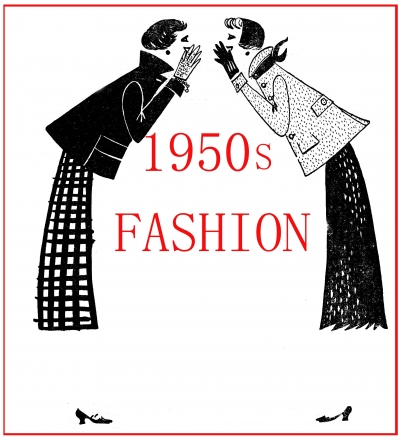
"Hair as short as a boy's and feathered into wisps about the face... Accented waist... Long slim look... Spread-eagle effect about the shoulders obtained by deep armholes, bloused backs, big collars or little capes... Mostly narrow skirts but still plenty of full ones."
- so begins the attached two page Spring fashion review that was torn from the Women's Page of the January 25, 1950 issue of Pathfinder Magazine. Judging from the six photographs that illustrate the column, Christian Dior continued call the tunes that other fashion designers had to dance to if they expected to attract a following. The New York designers whose efforts were singled out for praise were Lilly Daché, Hattie Carnegie, Ben Reig, Ceil Chapman and Vera Jacobs of Capri Originals.
More about 1950s hairstyles can be read here...
The antidote to the austere fashion deprivations of the 1930s and the wartime fabric restrictions that characterized the Forties arrived in the immediate post-war period when designers were at last permitted to make manifest their restrained cleverness and create an aesthetic style in a mode that was overindulgent in its use of fabric. This fashion revolt commenced in Paris, when Christian Dior showed his first collection in 1947 - couturiers in every style capitol in the West willingly kowtowed and a new era in fashion was born.
"Red is the color which is going to add excitement to the fall scene. In a season when black is everywhere, the woman who wants to stand out is going to turn to red to express her own sense of drama. Red will be seen in suits, in coats, in after-dark dresses. The color itself is so dramatic that designers rely on cut and line for interest." The slobs who run this website are a slovenly lot, so don't take our word for it - but we believe this hooded turtleneck sweater that showed up on fashion's catwalks during the fall of 1952 to have been the proverbial "bees knees"! Looking back, the fashion silhouette of the 1950s is remembered as having a very narrow waistline, but in the early days of the decade, as this 1951 fashion review indicates, the feminine waist was a highly contested battle ground:
"Where's the waist? Paris popped the question, but has yet to give the answer. On the one hand, many leading designers showed a tendency to raise the waistline. But they were challenged by a strong minority that seemed determined to drop it [pictures of both high and low are provided herein]...Apparently, Paris has decreed it the year of the wandering waist. Where it will stop may well be up to American women." If you'd like to read about the feminine silhouette of the early Forties, click here. "The new women's sweaters will probably disappoint collectors of pin-up art. They are designed, oddly enough, to appeal to women - the women of taste and discrimination who will wear them." |
MORE ARTICLES >>> PAGE: * 1 * 2 * 3 * 4 * 5 * > NEXT |
|